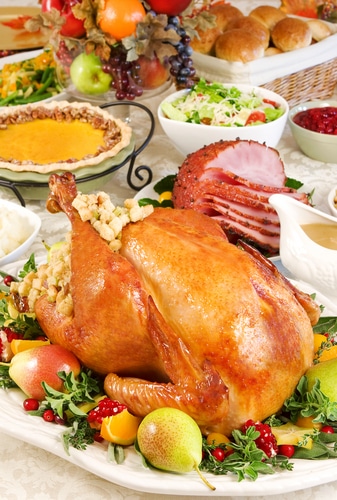 Thanksgiving is a time to reflect on everything life has given you, spend time with your friends and dine on decadent food. Food is a key part of this fall tradition with a whole turkey, rich vegetable dishes and plenty of pie being the key components. These dishes may seem healthy because they are nutrient-rich and made from whole foods. However, they are also high in fat and calorie dense.
Thanksgiving is a time to reflect on everything life has given you, spend time with your friends and dine on decadent food. Food is a key part of this fall tradition with a whole turkey, rich vegetable dishes and plenty of pie being the key components. These dishes may seem healthy because they are nutrient-rich and made from whole foods. However, they are also high in fat and calorie dense.
A single, large turkey leg with the skin has over 1,000 calories and 155 percent of the average person’s daily cholesterol allowance. Even half a turkey breast, toted to be healthier, is close to 1,600 calories if you eat the skin. All this and you haven’t even started with the side dishes.
One cup of mashed sweet potatoes has about 250 calories thanks to the added fat in cream or butter. Green beans are a healthy side dish but if they are turned into a casserole you’re adding fat through dairy and oils, which adds another 200 plus calories a serving. Canned cranberry sauce is 200 calories for just half a cup. By the time you’ve reached dessert, you’ve already eaten 1,500 to 2,000 calories. If you really binged, you may have consumed twice that amount. Follow with dessert, such as a single piece of homemade pumpkin pie, and 300 plus calories are added to the total.
Wine is another secret calorie contributor. At 125 calories per 5 fluid ounce glass, you are quickly adding calories to your overall balance. White wine has marginally fewer calories than red, at 121 calories per fluid ounce.
The Average Thanksgiving Meal is 3000 Calories
When all is said and done, the average person can eat about 3,000 calories in one meal. That’s with average consumption. Many people indulge at this decadent time of year and will consume much more than that. This one meal contains more calories than the average person should consume in a day.
Limit the number of calories you eat on Thanksgiving by changing your recipes. Avoid any turkey or meat with the skin on. Peel the skin off before you eat it and cut your calories significantly. Don’t slather butter or oil on the turkey while cooking it. Instead, cover it with herbs or other low-calorie seasonings. A 3-ounce piece of herbed turkey breast is only 140 calories. Half a turkey breast with the bone and skin removed is 413 calories, significantly less than its counterpart with skin. Even a turkey leg with the skin off is about 700 calories, 300 to 400 less than with the skin.
Thanksgiving Side Dishes
For side dishes, opt for whole vegetables that are seasoned with herbs instead of fats like cream or butter. Try blending baked squash with chicken or vegetable stock instead of butter. Season a pan of roasted root vegetables with plenty of herbs and a little healthy vegetable oil. Make cranberry relish using raw cranberries, apples, and oranges and grinding them in a food processor. Add just a touch of sugar to sweeten the dish. Use this instead of cranberry sauce.
Opt for plenty of fresh fruit when it’s time for dessert. Make chocolate banana pudding from scratch. The banana sweetens the pudding naturally so you don’t need to add as much sugar. If you eat pie, have half a slice.
Sparkling water with lemon or lime slices is a great alternative to alcoholic or sugar-laden drinks. Have just one glass of wine or a cocktail and then switch to sparkling water.
Bottom Line
Remember that while traditional Thanksgiving foods are heavy in calories, they are not necessarily “bad” foods. Many of them are rich in nutrients. Turkey has plenty of protein, iron vitamin B6, riboflavin and selenium. Vegetable side dishes will give you lots of vitamin C and can have beta-carotene, vitamin K, manganese and much more. Even pumpkin pie is rich in beta-carotene. The key is to prepare the dishes using as little cholesterol-rich fat as possible and to limit portion size. Offer many leaner dishes, such as steamed green beans, to help fill up your stomach while you enjoy smaller portions of the main dishes.

